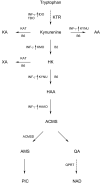A cross-sectional study of inflammatory markers as determinants of circulating kynurenines in the Lung Cancer Cohort Consortium
- PMID: 36653422
- PMCID: PMC9849351
- DOI: 10.1038/s41598-023-28135-9
A cross-sectional study of inflammatory markers as determinants of circulating kynurenines in the Lung Cancer Cohort Consortium
Abstract
Circulating concentrations of metabolites (collectively called kynurenines) in the kynurenine pathway of tryptophan metabolism increase during inflammation, particularly in response to interferon-gamma (IFN-γ). Neopterin and the kynurenine/tryptophan ratio (KTR) are IFN-γ induced inflammatory markers, and together with C-reactive protein (CRP) and kynurenines they are associated with various diseases, but comprehensive data on the strength of associations of inflammatory markers with circulating concentrations of kynurenines are lacking. We measured circulating concentrations of neopterin, CRP, tryptophan and seven kynurenines in 5314 controls from 20 cohorts in the Lung Cancer Cohort Consortium (LC3). The associations of neopterin, KTR and CRP with kynurenines were investigated using regression models. In mixed models, one standard deviation (SD) higher KTR was associated with a 0.46 SD higher quinolinic acid (QA), and 0.31 SD higher 3-hydroxykynurenine (HK). One SD higher neopterin was associated with 0.48, 0.44, 0.36 and 0.28 SD higher KTR, QA, kynurenine and HK, respectively. KTR and neopterin respectively explained 24.1% and 16.7% of the variation in QA, and 11.4% and 7.5% of HK. CRP was only weakly associated with kynurenines in regression models. In summary, QA was the metabolite that was most strongly associated with the inflammatory markers. In general, the inflammatory markers were most strongly related to metabolites located along the tryptophan-NAD axis, which may support suggestions of increased production of NAD from tryptophan during inflammation.
© 2023. The Author(s).
Conflict of interest statement
The authors declare no competing interests.
Figures



References
Publication types
MeSH terms
Substances
Grants and funding
- NU58DP006333/CC/CDC HHS/United States
- HHSN268201600002C/NH/NIH HHS/United States
- UM1CA182876/NH/NIH HHS/United States
- U01 CA182934/CA/NCI NIH HHS/United States
- HHSN268201600001C/NH/NIH HHS/United States
- P30 ES000260/ES/NIEHS NIH HHS/United States
- HHSN268201600018C/NH/NIH HHS/United States
- UM1 CA186107/CA/NCI NIH HHS/United States
- HHSN268201600003C/NH/NIH HHS/United States
- U01 CA167552/CA/NCI NIH HHS/United States
- R01CA144034/NH/NIH HHS/United States
- UM1 CA182910/CA/NCI NIH HHS/United States
- U19 CA203654/CA/NCI NIH HHS/United States
- UM1 CA173640/CA/NCI NIH HHS/United States
- P50 CA127003/CA/NCI NIH HHS/United States
- U01 CA164973/NH/NIH HHS/United States
- 001/WHO_/World Health Organization/International
- U01 CA164973/CA/NCI NIH HHS/United States
- 209057/WT_/Wellcome Trust/United Kingdom
- HHSN268201600004C/NH/NIH HHS/United States
LinkOut - more resources
Full Text Sources
Medical
Research Materials
Miscellaneous

